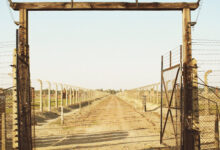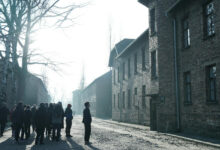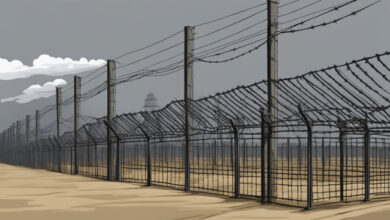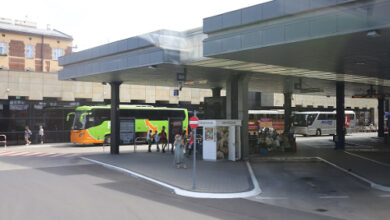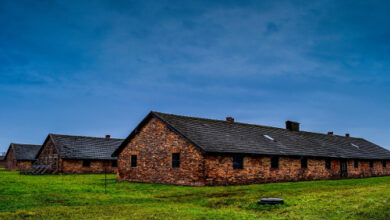Auschwitz Day Trip Itinerary from Krakow
Plan Your Visit: Auschwitz Day Trip Itinerary from Krakow
Planning a day trip to Auschwitz-Birkenau from Krakow is a sobering yet important experience. Our KrakowTOP Auschwitz Day Trip Itinerary from Krakow will guide you through the key details for planning your visit. Located about 70 km west of Krakow in the town of Oświęcim, this former Nazi concentration camp now serves as a memorial and museum. You can easily visit Auschwitz on a guided tour from Krakow, which typically lasts around 7 hours including transport.

Your journey will begin with a pickup from your Krakow accommodation. During the 1.5-hour drive, you’ll have time to prepare yourself mentally for the emotional experience ahead.
Upon arrival, you’ll join a guided tour of both Auschwitz I and Auschwitz II-Birkenau camps, learning about the tragic history of the Holocaust and seeing preserved buildings, personal artefacts, and exhibits.
After the tour, you’ll have a short break before returning to Krakow. Many Auschwitz tours offer optional lunch or the chance to visit other nearby sites. Be sure to book your tour in advance, as Auschwitz visits are strictly regulated and often sell out quickly.
This day trip offers a powerful glimpse into one of history’s darkest chapters and serves as a vital reminder of the importance of remembrance and human rights.
Planning Auschwitz Day Trip Itinerary from Krakow

A successful trip to Auschwitz requires careful preparation. Consider your tour options, transport arrangements, and essential items to bring for a smooth experience.
Choosing the Right Auschwitz Tour
You have several tour options for visiting Auschwitz from Krakow. Guided tours offer expert insights and often include hotel pickup. Look for tours with small groups for a more personal experience. Many tours provide a full refund if cancelled in advance, giving you flexibility.
Some tours include both Auschwitz and Birkenau camps. These offer a more complete understanding of the site’s history. Check if your chosen tour includes an English-speaking guide and entry tickets.
For those with mobility needs, enquire about wheelchair-accessible tours. Some operators offer special arrangements for visitors with disabilities.
Securing Transportation
If not opting for a tour with transport, you’ll need to arrange your own. Buses run regularly from Krakow to Auschwitz, taking about 1.5 hours. Book tickets in advance, especially during peak season.
Hiring a private car or taxi is another option. This gives you more control over your schedule but can be pricier.
Some visitors choose to rent a car. This allows for stops at other sites but requires navigating unfamiliar roads.
What to Bring with You
Pack thoughtfully for your visit. Comfortable shoes are important, as you’ll be walking and standing for long periods.
Bring your passport or ID; it’s required for entry. A small bag with water and snacks is useful, as food options on-site are limited.
Consider packing a lunch box if your tour doesn’t include meals. Weather-appropriate clothing is crucial, as much of the tour is outdoors.
Don’t forget a camera to document your visit, but be mindful of photography rules in certain areas.
The Journey from Krakow to Auschwitz
Getting from Krakow to Auschwitz is straightforward. You have several travel options, and the trip takes about 90 minutes each way. Here’s what you need to know about the journey.
Travel Options and Duration
You can reach Auschwitz from Krakow by bus, train, or car. Buses are a popular choice, leaving regularly from Krakow’s main bus station. The journey takes around 90 minutes, depending on traffic.
Trains also run from Krakow to Oświęcim (the Polish name for Auschwitz). This option can be slightly slower than the bus but offers a more comfortable ride.
If you prefer more flexibility, you can drive. The distance is about 70 kilometres, and the route is well-signposted. Remember to factor in time for parking once you arrive.
Whichever option you choose, plan to leave Krakow early. This will give you ample time for the journey and the tour itself.
Meeting Your English-Speaking Driver
Many tours offer hotel pickup in Krakow. Your English-speaking driver will collect you from a pre-arranged meeting point. This is often your hotel or a central location in the city.
Be ready at the agreed time. Drivers usually arrive a few minutes early. They’ll be easy to spot, often holding a sign with your name or tour group.
During the drive, your guide may share information about the history of Auschwitz. This can help prepare you for the visit. Don’t hesitate to ask questions during the journey.
Accessibility Information
Auschwitz is partly accessible for visitors with mobility issues. The main camp, Auschwitz I, has some wheelchair-friendly paths. Auschwitz II-Birkenau is more challenging due to uneven ground.

If you have specific accessibility needs, inform your tour operator in advance. They can often make arrangements to accommodate you.
Wear comfortable shoes for your visit. You’ll be walking on various surfaces, including gravel and uneven ground. The tour involves a lot of standing, so proper footwear is essential.
In colder months, dress warmly. Much of the tour takes place outdoors, and there’s little shelter from the elements.
The Holocaust and History of Auschwitz
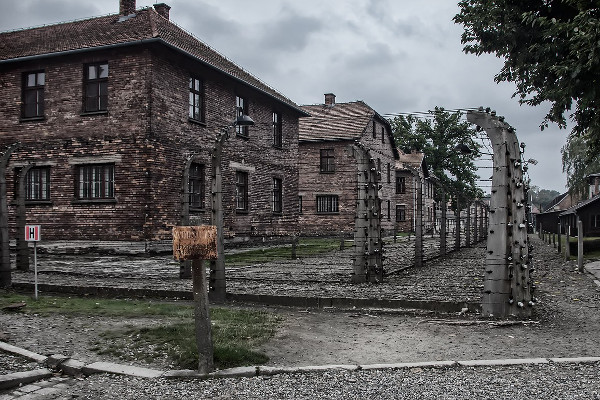
Auschwitz stands as a stark symbol of the Holocaust and Nazi atrocities during World War II. This complex of concentration and extermination camps saw the brutal deaths of over a million people.
Origins and Function of the Camp
Auschwitz began as a Polish army barracks in 1940. The Nazis quickly turned it into a concentration camp for political prisoners. As the war progressed, it grew into a vast network of camps.
The main camp, Auschwitz I, held prisoners and conducted cruel experiments. Auschwitz II-Birkenau became the largest extermination site. Auschwitz III-Monowitz forced prisoners to work in nearby factories.
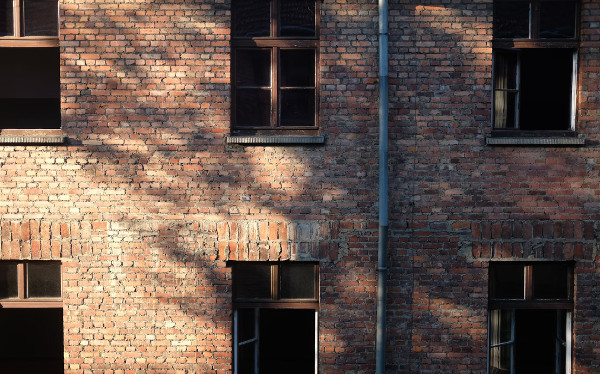
The Nazis designed the camp to carry out the “Final Solution” – the planned genocide of European Jews. They also targeted other groups like Roma, Poles, and Soviet prisoners of war.
Life of the Prisoners
Prisoners at Auschwitz faced unimaginable hardships. Upon arrival, guards separated families. They forced able-bodied adults into slave labour. The weak, elderly, and children often went straight to the gas chambers.
Daily life was filled with hunger, disease, and abuse. Prisoners slept in cramped, unsanitary barracks. They worked long hours with little food. Guards subjected them to random beatings and executions.
Despite these conditions, some prisoners formed resistance groups. They tried to document Nazi crimes and help fellow inmates survive.
World War II and Nazi Germany
Auschwitz played a key role in Nazi Germany’s war efforts. It supplied slave labour to nearby factories. The camp also furthered the Nazi goal of racial “purification”.
As Allied forces advanced in 1944, the Nazis increased the pace of killings. They tried to hide evidence of their crimes by destroying records and gas chambers.
When Soviet troops neared in January 1945, the SS forced prisoners on death marches westward. Those left behind were liberated on 27 January, a date now marked as International Holocaust Remembrance Day.

Touring Auschwitz I and Auschwitz II-Birkenau
A visit to Auschwitz involves touring both Auschwitz I and Auschwitz II-Birkenau. These sites offer a sobering look at the Holocaust and Nazi crimes. You’ll see original buildings, exhibits, and memorials that tell the story of this dark period in history.
Exploring the Museum and Memorial
At Auschwitz I, you’ll find the main museum. It’s housed in former prison blocks. Each block focuses on a different aspect of camp life and the Holocaust.

You’ll see personal items taken from prisoners. These include suitcases, shoes, and glasses. Photos and documents are also on display.
The museum shows how the camp worked. You’ll learn about daily life for prisoners and the brutal conditions they faced.
One of the most moving parts is Block 11. This was the camp prison. Here, you can see the “Death Wall” where many executions took place.
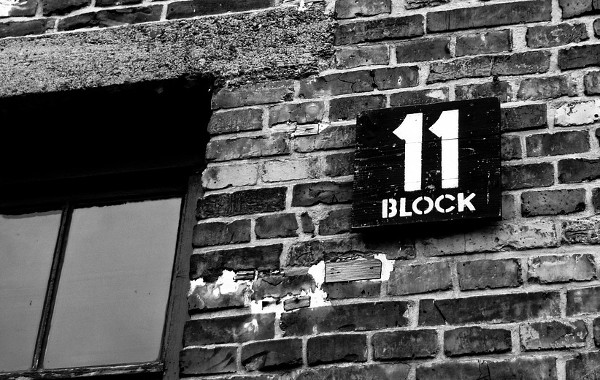
Visiting the Memorial’s Visitor Service
The Memorial’s Visitor Service is your starting point. Here, you can get maps and information about the site.
You can also join guided tours. These are led by expert guides who know the camp’s history well.
Audio guides are available in many languages. They provide in-depth information as you walk through the site.
The service offers educational materials too. These can help you better understand what you’re seeing.
It’s a good idea to book your visit in advance. This is especially true in peak season when it can get busy.
Observing the Original Barracks and Gas Chambers
At Auschwitz II-Birkenau, you’ll see the vast size of the camp. This gives you a sense of the scale of the Holocaust.
The entrance is marked by the iconic gatehouse and railway tracks. Trains brought prisoners directly into the camp through here.

You can walk through the remains of the barracks. These show the cramped and harsh living conditions prisoners endured.
The ruins of the gas chambers and crematoria are also here. These are powerful reminders of the camp’s deadly purpose.
At the end of the railway tracks stands the International Monument. It honours all who suffered and died at Auschwitz.
Etiquette and Reflection

Visiting Auschwitz requires thoughtful conduct and introspection. Your approach should balance respect for the site’s history with personal contemplation.
Respecting the Site of Tragedy
As you enter Auschwitz, you’ll see the sign ‘Arbeit macht frei’. Maintain a solemn demeanour throughout your visit. Follow your licensed guide’s instructions carefully. Refrain from eating, smoking, or using mobile phones during the tour.
Dress modestly and comfortably. Avoid wearing clothing with offensive slogans or imagery. Keep your voice low and avoid disruptive behaviour.
When viewing artifacts or entering buildings like the crematoria, be mindful of other visitors. Don’t touch displays or take photographs where it’s prohibited. Your guide will inform you of appropriate times for questions. For more details about Etiquette read our KrakowTOP guide Rules and Etiquette for Visiting Auschwitz Memorial
The Importance of Remembrance
Your visit to Auschwitz is a powerful act of remembrance. Take time to reflect on the lives lost and the lessons of history. Consider watching the documentary film at the visitor centre before your tour.
As you walk through the camp, try to absorb the gravity of what occurred here. Read the personal stories and examine the photographs on display. These individual accounts bring humanity to the statistics.
After your visit, you might feel overwhelmed. It’s normal to need time to process your experience. Consider discussing your thoughts with fellow travellers or writing in a journal. Remember, by bearing witness, you help ensure such atrocities are never forgotten or repeated.
Frequently Asked Questions
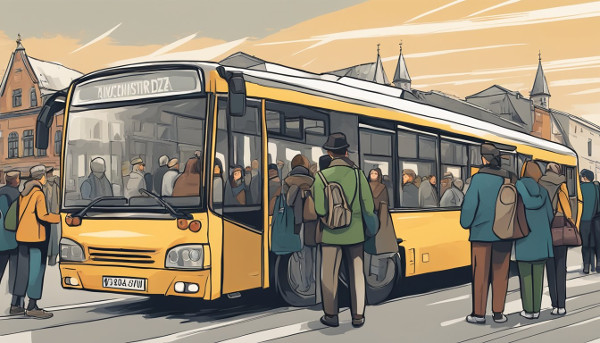
Planning a day trip to Auschwitz from Krakow involves several key considerations. Here are answers to some common questions to help you organise your visit.
What is the most efficient mode of transportation for a day trip from Krakow to Auschwitz?
The most efficient way to travel from Krakow to Auschwitz is by guided tour bus. These buses are comfortable and take you directly to the site without any stops.
You can also rent a car, which gives you more flexibility. However, parking at Auschwitz can be tricky during busy periods.
How long does it take to travel from Krakow to Auschwitz?
The journey from Krakow to Auschwitz typically takes about 1.5 hours by car or bus. This can vary slightly depending on traffic conditions.
Plan for a total travel time of 3 hours for the round trip. This allows for any minor delays or unexpected traffic.
Are there any guided tour packages for Auschwitz that include hotel pickup from Krakow?
Yes, many tour operators offer packages with hotel pickup in Krakow. These tours often include:
- Round-trip transportation
- A guided tour of Auschwitz-Birkenau
- Entry tickets
- An English-speaking guide
Booking a tour with hotel pickup can save you time and hassle, especially if you’re unfamiliar with Krakow.
What is the approximate cost of a day trip to Auschwitz when departing from Krakow?
The cost of a day trip to Auschwitz from Krakow can vary. Here’s a rough breakdown:
- Guided tours with transport: £40-£60 per person
- Self-guided visits with public transport: £15-£25 per person
- Private tours: £100-£200 per person
Prices may change based on the season and demand. It’s best to book in advance for better rates.
Do any tours offer comprehensive itineraries that cover the key sights of Auschwitz in a single day?
Many tours provide comprehensive itineraries covering both Auschwitz I and Auschwitz II-Birkenau in one day. These typically include:
Start Planning Your Krakow Trip Now!
- Unsure where to stay in Krakow? Discover top-rated Old Town and Kazimierz hotels with Booking.com.
- Book your airport transfer now and enjoy a hassle-free ride directly to your hotel. Driver will meet you at John Paul II International Airport Kraków–Balice.
- Take a Tour of Auschwitz. Arrange a visit to the Auschwitz-Birkenau Memorial and Museum to pay tribute and learn about this significant historical site.
⚠️ EASTER BOOKING ALERT: Auschwitz tours are filling rapidly for the holiday period. Secure your visit now to guarantee your preferred date and time slot. Last-minute availability cannot be guaranteed during this peak season. Due to high demand during Easter, it’s strongly recommended to book your tickets and tour to Auschwitz well in advance to secure your preferred dates and times! 🔖
- Explore the Fascinating Wieliczka Salt Mine! Book your guided tour today. These tours are very popular, so book early to avoid disappointment and ensure your spot.
- Looking for ideas? Check out our KrakowTOP.org recommended itineraries, including the famous Christmas Market, holiday events, and must-see Krakow attractions like Wawel Castle, Oskar Schindler’s Factory and St. Mary’s Basilica.
- A tour of Auschwitz I, including the main camp and museum
- A visit to Auschwitz II-Birkenau, the larger extermination camp
- Time for reflection and paying respects at key memorial sites
Tours usually last 6-7 hours, including travel time from Krakow.
What are the travel options for reaching Auschwitz from Krakow by public transport?
Public transport options from Krakow to Auschwitz include:
- Bus: Regular buses run from Krakow’s main bus station to Auschwitz. The journey takes about 1.5-2 hours.
- Train: Trains run from Krakow to Oswiecim (the Polish name for Auschwitz). From there, you’ll need to take a short bus ride to the museum.
Public transport is cheaper but less convenient than guided tours. You’ll need to plan your timings carefully to make the most of your day.
